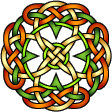 Mac Lean
Mac Lean
 |
One of the great seafaring clans of the Hebrides, where they exercised
an important influence from an early period, the Mac Leans became scattered through many
islands from Rum to Islay, and split into a number of branches of which several maintained
a separate existence.
In the days of the Lords of the Isles the Mac Leans formed an active
and lively part of the island host. They first come into prominence through the marriage
of Lachlan, son of John called "Maguilleon"( MacGill'
Eathain, son of the
servant of John), to a daughter of John Lord of the Isles, for which a papal dispensation
was authorised in 1367 as they were nearly related. This Lachlan, nicknamed "the
wily", had a charter of Duart castle and neighbouring lands from his brother-in-law
Donald of the Isles in 1390, with a share in the keeping of Cairnburgh, Dunchonnel and
other royal castles off the coast of Mull, and the office of Steward of the household and
bailie in Tiree. This gave the Duart family a leading place in the clan, and an importance
even in national affairs. While James I was a prisoner in England, Lachlan'
s son
Hector had a safe conduct from Henry IV to visit "his liege lord the king of
Scotland"just before direct negotiations were entered into with Donald of the Isles,
and in 1411 Lachlan fell at Harlaw in supporting Donald'
s struggle for the earldom of
Ross. In the next generation a twice-married chief founded the families of Coll and
Ardgour, and a group in the Ross of Mull known as "the race of the iron sword".
The clan was steadily growing in strength and influence, and both Duart and Lochbuie
(descended from a brother of the wily Lachlan) were numbered among the island magnates who
sat in council at Finlaggan in Islay.
After the lordship was forfeited in 1493 Hector of Duart had his
family'
s earlier grants of 1390 confirmed by royal charter, and thus they came to
hold lands and offices direct from the crown. As he had no lawful son of his own, Hector
secured letters of legitimisation for his natural son Lachlan, who displaced at least one
legitimate heir when he had a charter of the barony of "Dowarde"in 1496.
During the minority of Queen Mary and the years that followed, the Mac
Leans reached the height of their power. A brother of Duart was one of the commissioners
appointed to treat Henry VIII during Donald dubh'
s rebellion in 1545. Mac Lean
infiltration into Islay and Jura menaced the trade-route between Scotland and Ireland, and
a bitter feud with the Mac Donalds had disastrous consequences for the Mac Leans.
The crown rents of Duart went unpaid, and, in 1604, the chief had to
agree to deliver the castle to the king'
s representative on demand; along with
Lochbuie and Coll, he accepted the "Statutes of Iona", and promised to appear
before the Privy Council annually with a certain number of their kinsmen. Sir Lachlan,
created a Baronet of Nova Scotia in 1633 with a nominal estate in Anticosti, borrowed
money from Argyll, who secured a further hold over him by paying up what was due to the
crown and other creditors.
The Mac Leans were the centre of the king'
s supporters in the
Western Isles, and their losses in men and money, together with a succession of five
minorities (1648-1716), enabled Argyll to wage a "private war"in the field and
in his own courts for possession of the Mac Lean lands in Mull, Morvern and Tiree. After
the Revolution Sir John Mac Lean formally conveyed Duart to Argyll, and the family
remained landless until 1783, when Sir Allan (who had been host to Dr. Johnson at
Inchkenneth) made good his claim to the lands of Brolass in the Ross of Mull. Duart housed
a garrison up to the end of the 18th century, after which it became a ruin, but it was
brought back and restored by Sir Firzroy Mac Lean of Duart. Since 1912 it has been the
chief'
s permanent home, and the family are determined that the castle of their
ancestors shall never again pass into other hands. |
|
|



